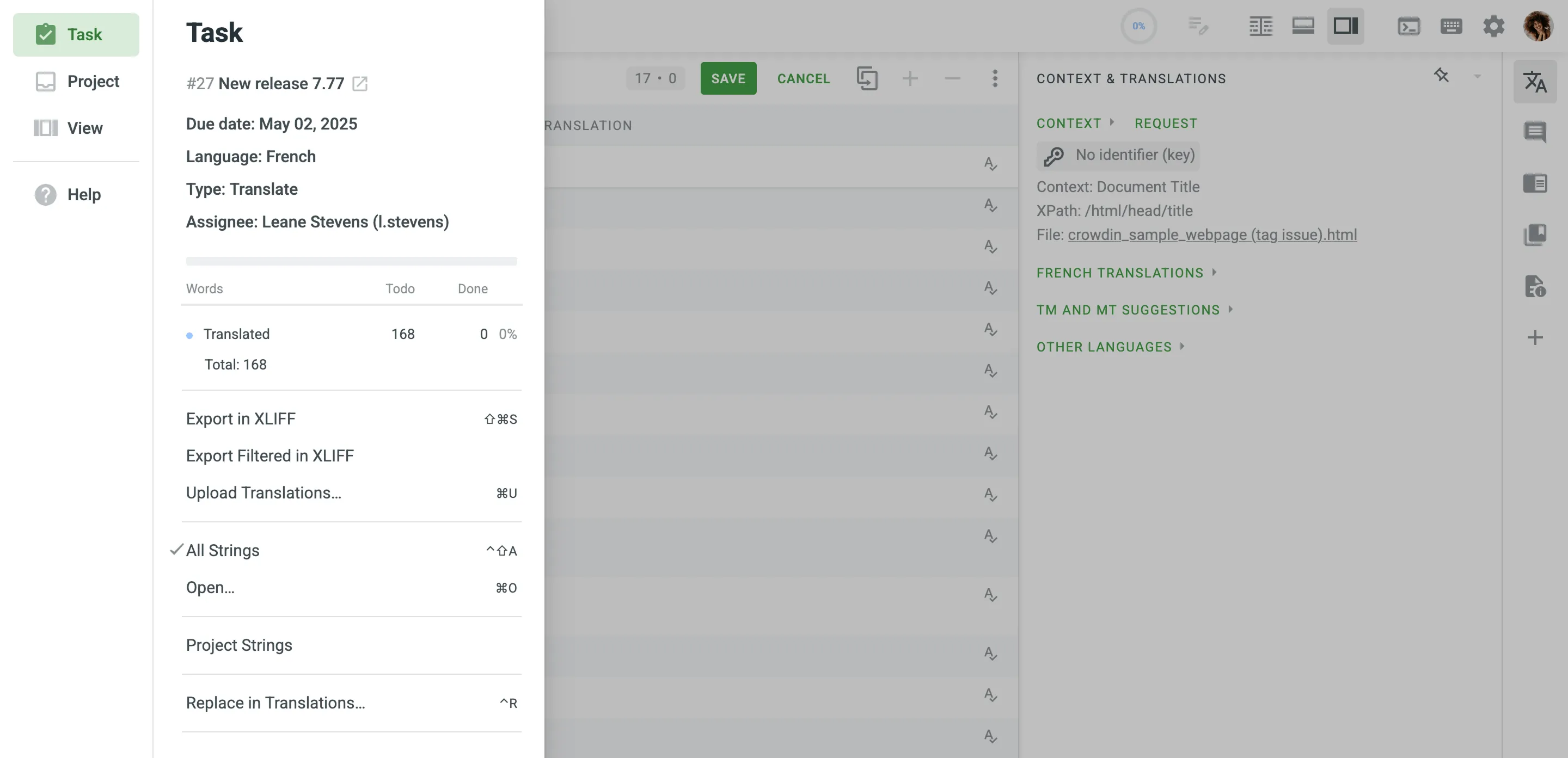Editor Overview
The Editor is the main place in Crowdin where project members can work on translations. It allows users to suggest, vote on, review, and approve translations online.
Using the Main menu in the upper-left corner, you can switch between files for translation, change translation languages, contact a manager, change the view, and access help materials.
The Editor provides all the necessary tools for translators and proofreaders, including:
- List of strings available for translation, which may vary in different Editor modes.
- Context, labels, and additional information to guide the work.
- String search and filtering options for efficient translation management.
- AI Assistant, Translation Memory (TM) suggestions, and Machine Translation (MT) suggestions.
- Glossary terms to ensure consistency.
- Comments section for collaboration and reporting issues.
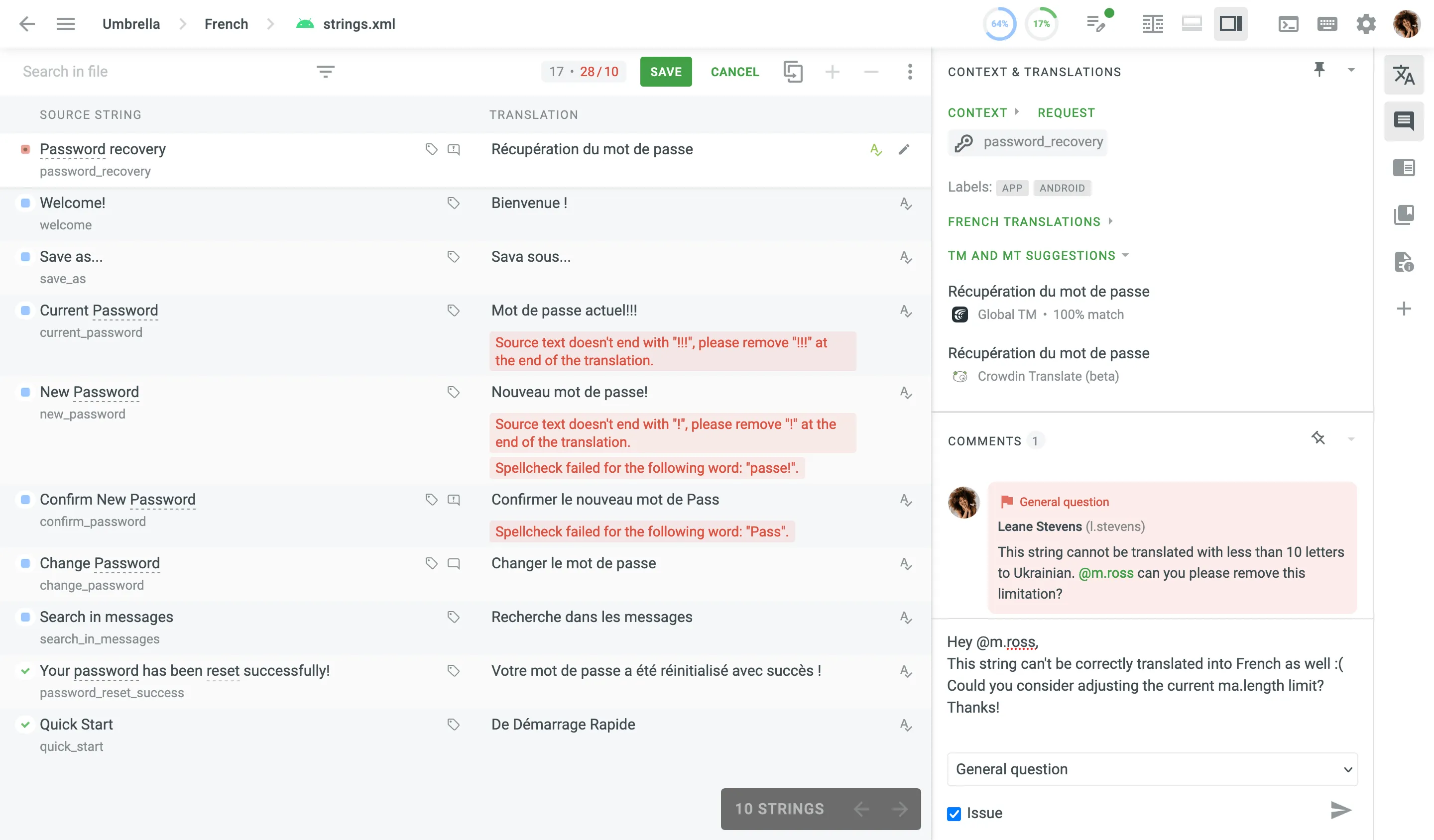
This section displays the list of strings, with the active one highlighted. Strings are text elements that are either individual words, phrases, or sentences. Some strings might have replacement tokens (e.g., 0, 1, %1, etc.) or elements of the ICU message syntax. Such items themselves should not be translated but are used by the website code to dynamically insert some information into strings. To work with such strings, you should copy the source string and translate only the real words.
Strings can have the following statuses:
- - untranslated
- - partially translated (if some of the plural forms are not translated)
- - translated
- - partially approved (if some plural forms are not approved)
- - approved
- - hidden (visible only for project managers and proofreaders)
There also might be the following icons besides strings:
- - the string has comments from contributors
- - the string has an unresolved issue
- - the string has labels
To suggest a translation, select a string from the list and enter your suggestion in the field next to the original text. When you’re done, click Save. Your suggestion will be added to the string’s translation suggestions list, and you’ll automatically move on to the next string.

Review the translations to make sure they are ready for export, and click Approve icon next to the suggestion to approve each translation separately.
To approve all or a couple of the strings at once, check the boxes on the left and then click Approve.

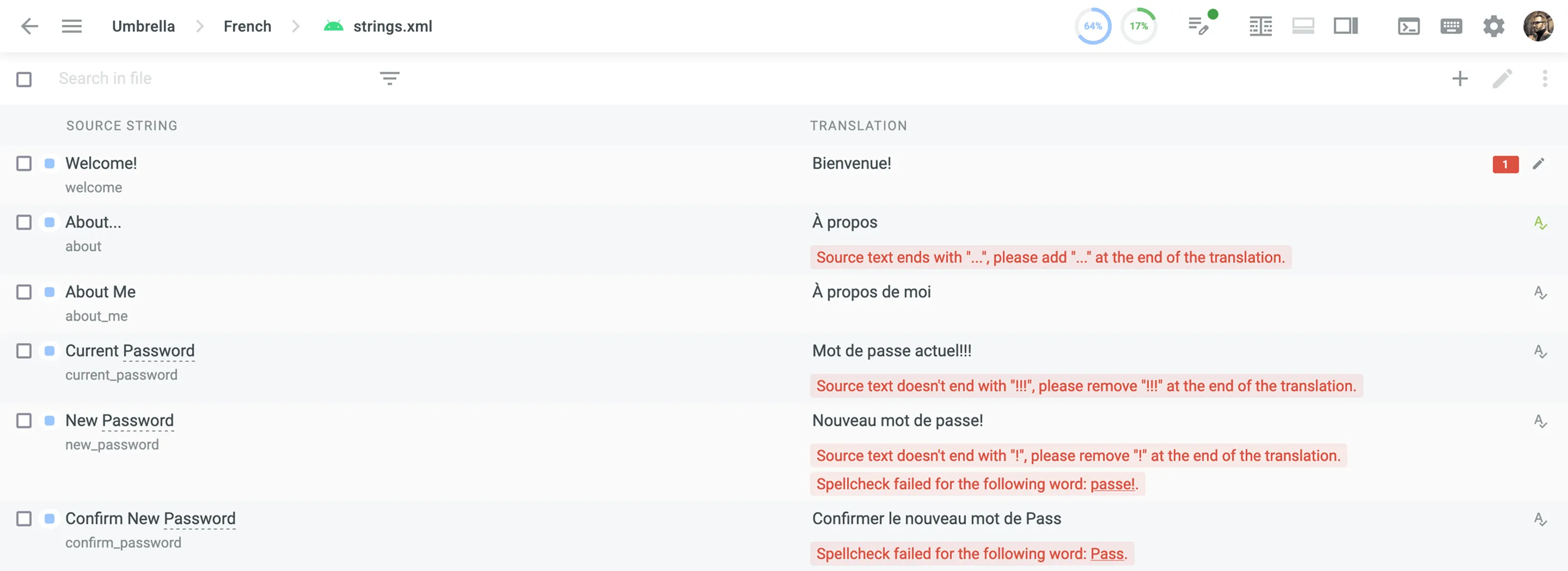
When translating the content of an HTML, XML, TXT, DOCX, XLSX, HAML, Web XML, Markdown, MDX, DITA, Wiki, ADOC, Coffee, FTL, JS, TS, and FTLH file formats, you can toggle a bottom panel (for Side-by-side and Multilingual modes) to see a file preview (i.e., WYSIWYG). For Comfortable mode, the file preview is displayed by default when working with the formats mentioned above.
The string status is indicated by the following colors:
- Red - untranslated
- Blue - translated
- Light-green - approved
- Gray - not for translation
An active string is highlighted in yellow.
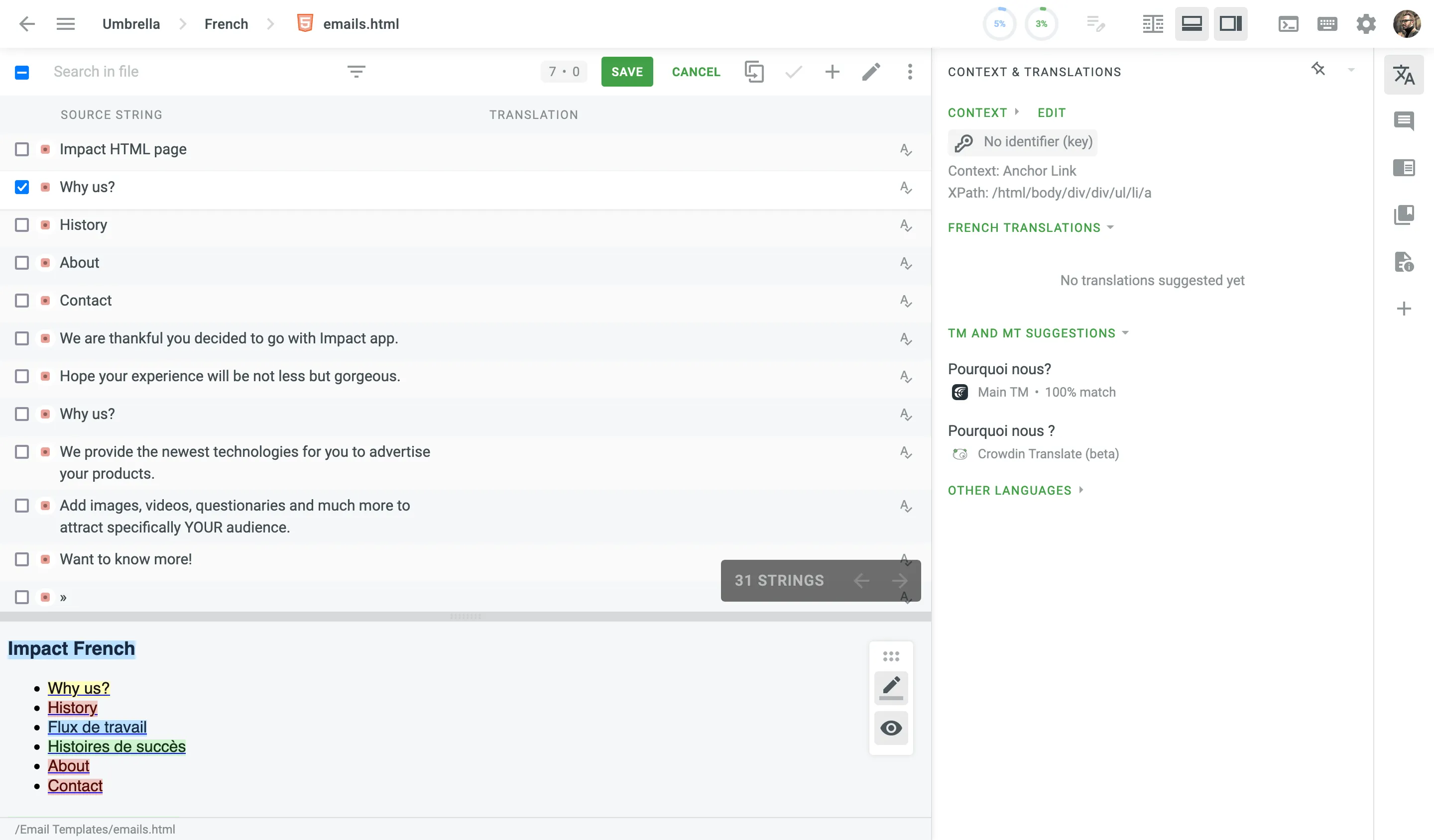
The following options are available to manage the above view:
- - Load basic list view. Use it to switch to a standard mode and see a list of strings (Comfortable mode only).
- - Highlight untranslated, translated, and approved strings. Use it to toggle the color highlighting of strings on and off.
- - Show translation preview. Use it to toggle the translation preview mode on and off.
- - Scale Toggle. Use it to toggle between a zoomed-in and zoomed-out view (Comfortable mode only).
You can search for strings by source text, translations, context, or all at once. Depending on the content you open in the Editor, the system will search for matches within the currently open file or across all strings in the project.
To search for strings in the file or the whole project, type your search phrase in the Search in file (Search strings) field. You can also use a keyboard shortcut to switch to the search field (by default, Ctrl +F ).
To refine the search results, you can use the following options:
- Match case – with this option, you will find only the strings written in the same case: for example, if you search for
Workand select Match case, the system will findWork,Works,Workingbut notwork. - Match whole phrase – with this option, you will find the strings containing the search phrase only in the original order: for example, if you search for
Machine Translationand select Match whole phrase, the system will findMachine Translation,Machine translation,machine translationbut notTranslation Machine. When Match whole phrase is not selected, the system splits the search phrase into separate words and searches for matches in the strings in any order. - Exact match – with this option, you will find only the strings that exactly match the search phrase: for example, if you search for
Workand select Exact match, the system will findWork,work, but notWorksorWorking.
You can combine Match case with Exact match and Match case with Match whole phrase. Match whole phrase and Exact match are mutually exclusive options.
The search phrase is limited to 128 characters. If you use a search phrase longer than 128 characters, it is automatically truncated to the maximum allowed.
To search for strings by a numeric identifier, type the number without quotation marks, such as 34354, to find the exact match. To search for the occurrences of the number in the text or context, enclose the number in quotation marks when typing it in the search box, for example: “34354”.

To filter the strings displayed in the left sidebar, click and select the preferred filter option.
Available filter options:
- Show All – Show all strings from the open file/folder in their original order.
- All, Untranslated First – Show all strings from the opened file/folder. Untranslated strings are displayed at the top of the list, followed by translated strings, and then approved ones are displayed at the bottom of the list.
- Untranslated – Show only strings without any translations.
- Need to Be Voted – Show already translated strings.
- Not Approved – Show strings that are already translated but not yet approved by a proofreader.
- Approved – Show only strings with approved translations.
- QA issues – Show strings with no QA issues or with unresolved QA issues in the current language.
- Machine Translation – Show strings that are translated by TM or MT suggestions without changes. Often these strings require additional review.
- With Comments – Show strings that have comments.
- With Unresolved Issues – Show strings with unresolved issues in the current language or all languages.
- Hidden – Show strings that are hidden from translators. Strings can be hidden by project managers or automatically hidden by Crowdin when they are marked as duplicates.
- Advanced Filter – A filter that allows you to configure custom filtering and sorting parameters.
- AI/CroQL Filter – An AI-powered filter that allows you to create custom queries using the Crowdin Query Language (CroQL) for enhanced string filtering.
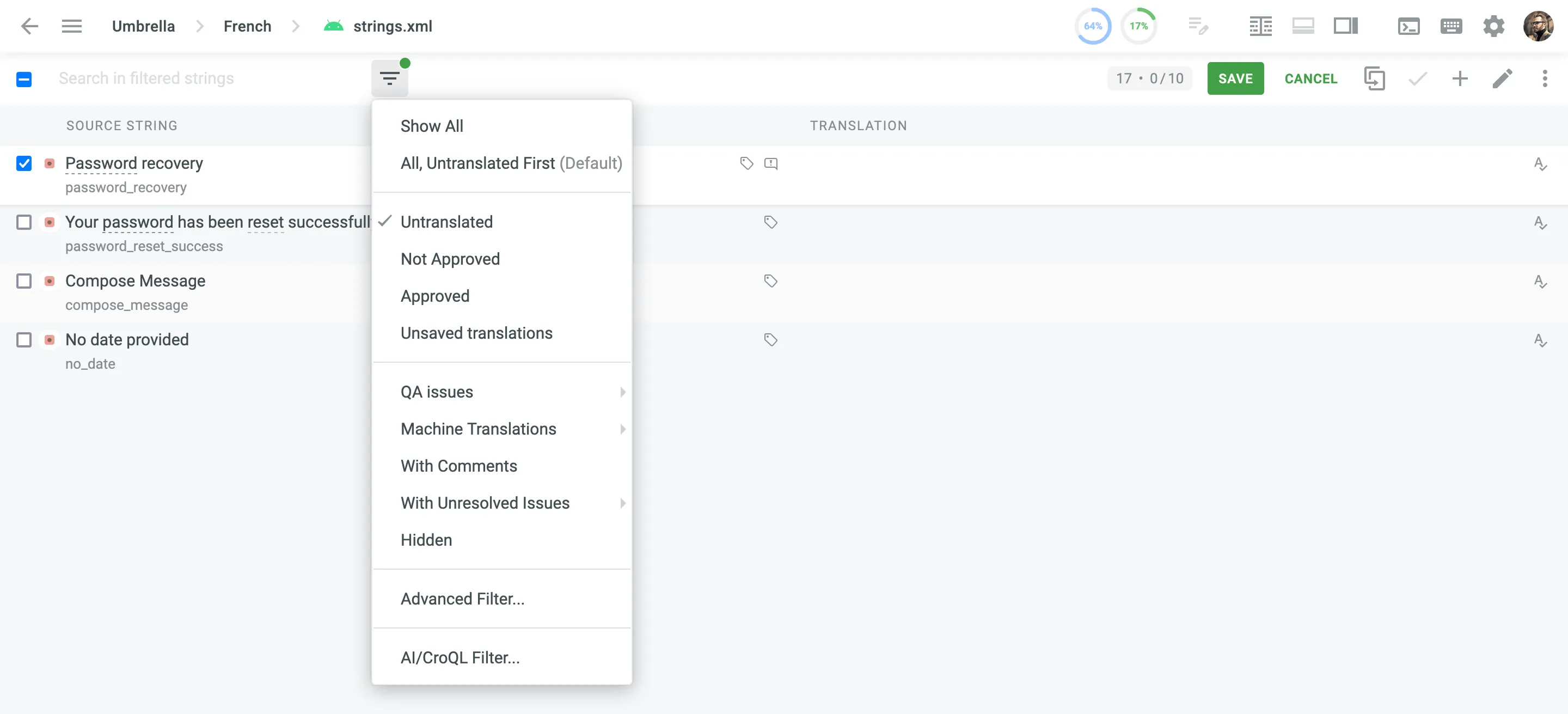
Verbal expressions allow you to search for strings that match specific patterns, such as formatting, punctuation, or variable placement. This feature is available in the Advanced Filter.
Some strings may have plural forms. Depending on the language, the number of plural forms may vary. For example, Chinese has one plural form, English has two plural forms, and other languages may have up to six plural forms. Crowdin works with plural forms according to the CLDR Language Plural Rules.
Read more about CLDR Language Plural Rules.
If a string has multiple plural forms, all variants of the string are displayed in the section where you type in translations. Enter translations in the appropriate sections that display the plural forms of the target language.
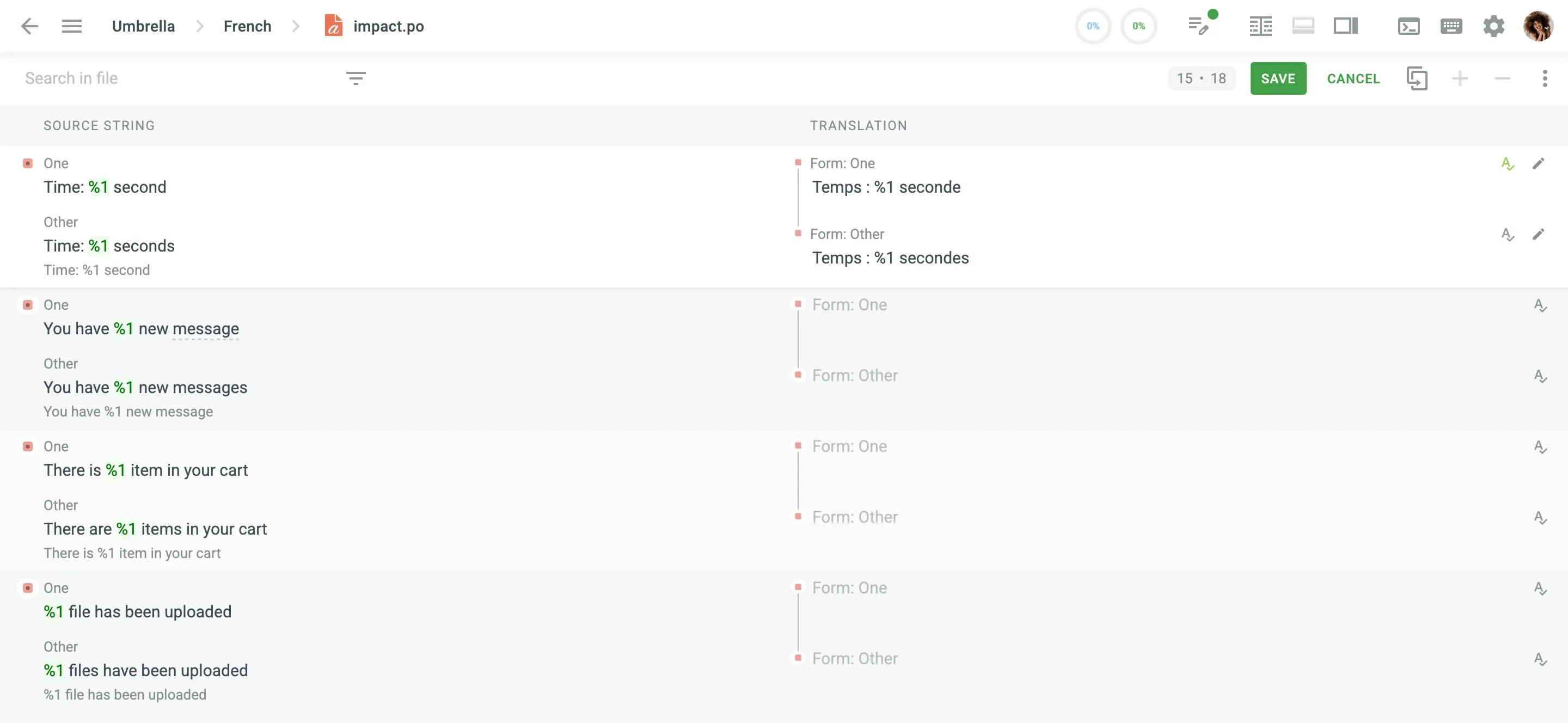
You might also get automatic Quality Assurance (QA) check pop-up messages to avoid some translation inaccuracy. For example, you can see notifications about inconsistency in punctuation, space mismatch, missing variables, and more.

Clicking in the upper-right allows you to:
- Remove Approval – Remove the approval for a translation, reverting its status to unapproved. (Available for proofreaders or higher.)
- Remove Translation – Clear translations for the selected strings along with the associated TM records. Duplicate translations from master strings remain unaffected.
- Hide/Make Visible – Toggle the visibility of a string for translators. Hidden strings are accessible only to project managers or higher.
- Pre-translate – Initiate pre-translation directly in the Editor using Translation Memory (TM), Machine Translation (MT), or AI.
- Copy String URL – Access a specific string using its unique link or share it with colleagues.
- Copy Source Skeleton – Copy untranslatable elements to the translation section. Useful when translating strings with ICU message syntax or HTML tags.
- Clear Selected Input – Clear the translation field for the selected string.
- Translation History – View all the modifications made to the string.
- View String In Context – Display the string along with other strings surrounding it in the source file, helping you understand its context better.
- Labels – Add or manage labels assigned to the string, helping to categorize or identify it for specific purposes.
- Max. Length – View and edit the maximum character length allowed for the string translation. Clicking this option opens a modal with the following settings:
- Proportional to source texts – Set the maximum length as a percentage of the source text length. Use the slider or manually enter a percentage (e.g., 100%, 150%, 200%) to define the limit.
- Fixed max. length – Specify an absolute character limit for the string translation.
- Unlimited – Allow translations of any length without restrictions.
- Delete String – Permanently remove the string from the project. (Available to project members with manager permissions or higher.)
In the translation window, you will also see the Maximum length of translation limit if it’s exceeded.
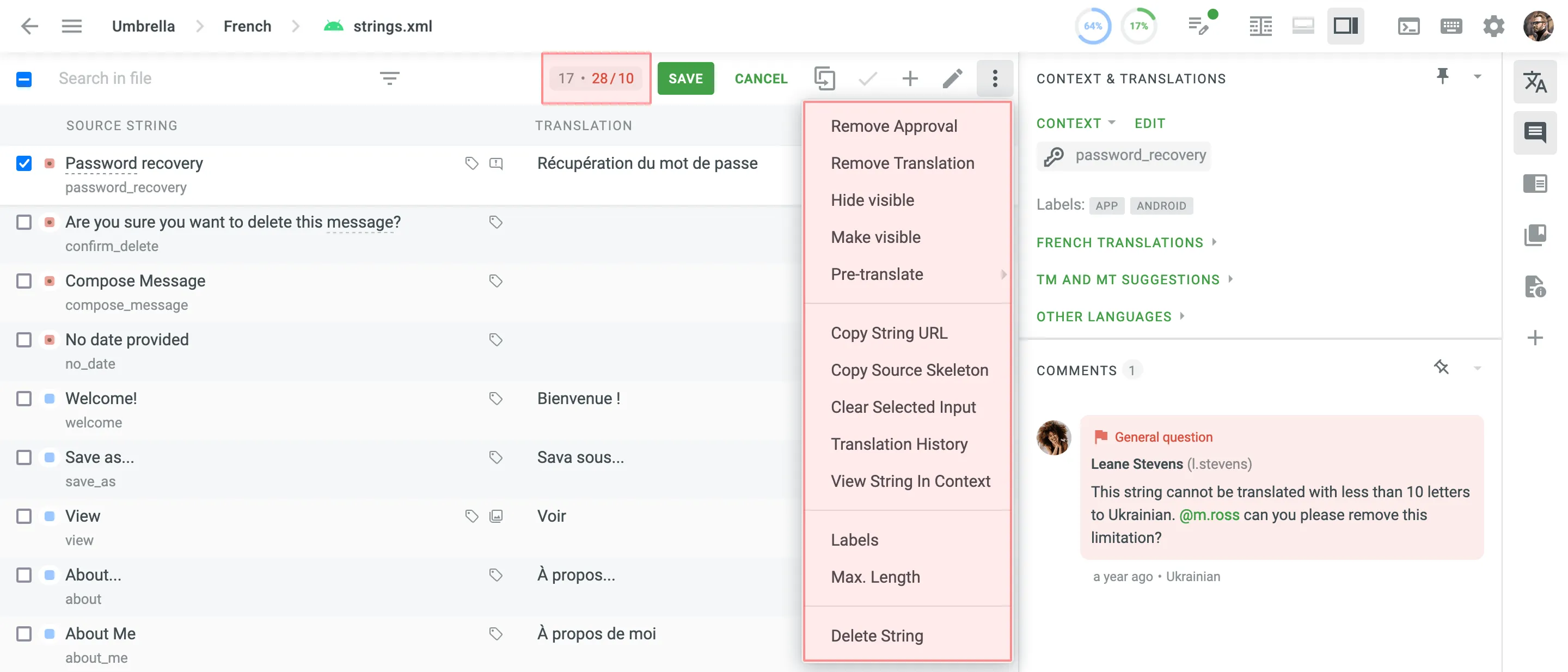
Additional action buttons available when translating a string:
- - Copy Source. Use it to keep the initial string structure while translating messages with replacement tokens or elements of ICU message syntax.
- - Clear. Use it when you need to clear the translation field quickly. Alternatively, use the Clear Selected Input option from the string menu.
- - Text selection mode. Use it when you want to copy a part of the translation from Translation Memory (TM) or Machine Translations (MT) (Comfortable mode only).
This section contains the resources that might be useful:
- Context, labels, screenshots, and additional information to guide the work.
- Translations by other project members
- Translation Memory (TM) suggestions
- Machine Translation (MT) suggestions
- Translations to other languages
Click on one of the suggestions, and it will automatically appear in the translation field. Refer to it as a basis for your own suggestions.
TM suggestions may include additional details such as the TM name, match percentage, creation date, and, if available, the name of the contributor who originally submitted the translation (displayed as full name and username, e.g., by Michael Ross (m.ross)). This information helps provide more context about the source and relevance of each suggestion.
To quickly copy the TM or MT suggestion to the translation field and save it, click Use and Save on the desired suggestion.
Other Languages section allows you to check the string translations into other target languages. This can be a useful tip for multilingual people and while translating dialects of a language.
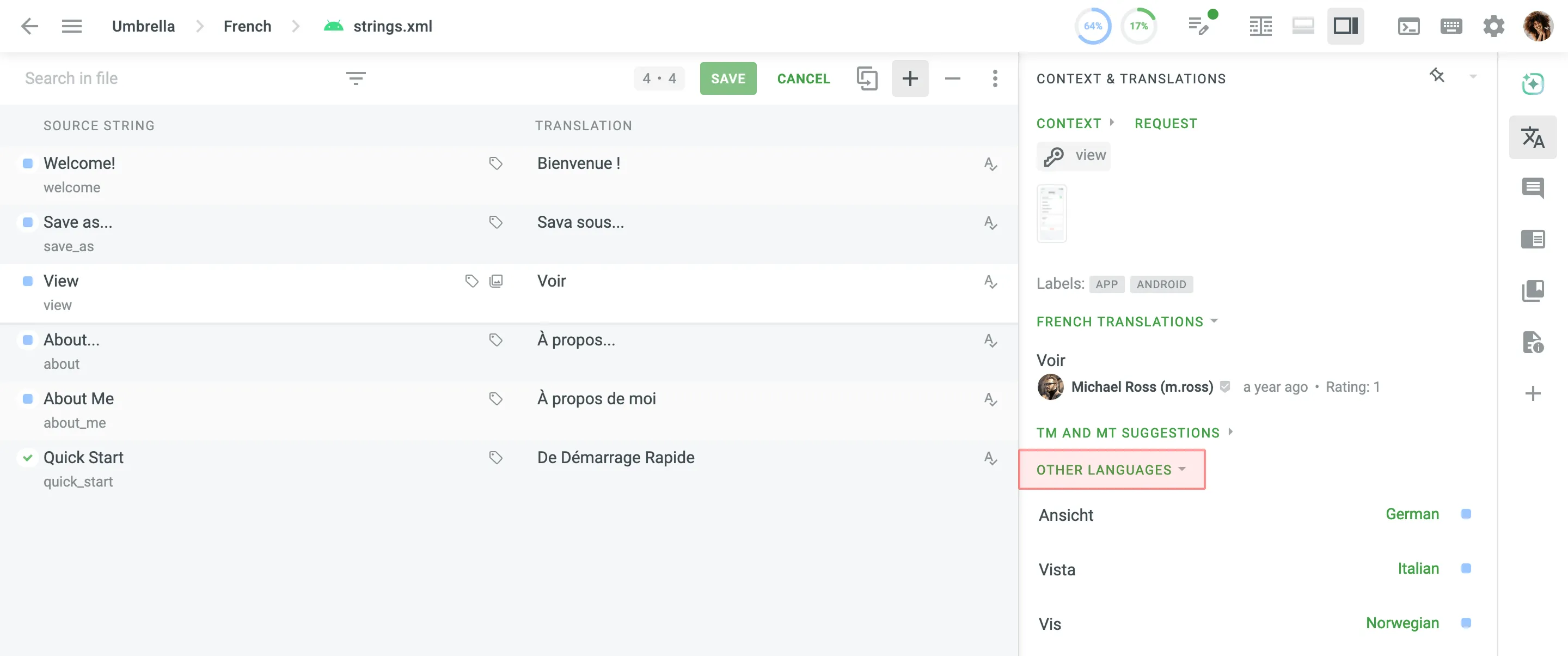
If you see that there is already a correct suggestion, vote for it by clicking the plus sign if you like the translation, or the minus sign if you don’t think the translation is correct. Translations that receive the most positive votes will have a higher rating and will appear at the top of all available translations for the string.
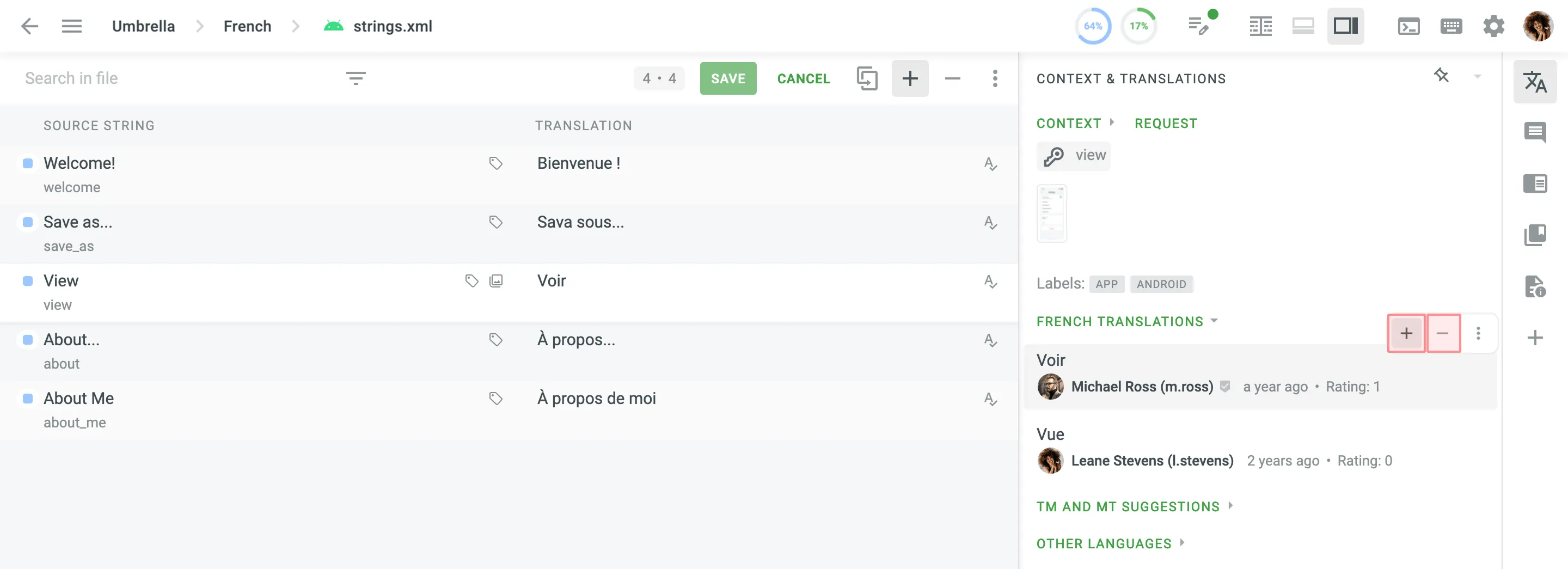
Within the Context & Translations section, you can find the context for each string, which may include technical details, a description of where the string appears in the product, or a screenshot showing its location in the user interface. If a string lacks context and its meaning is unclear, click Request to notify a project manager that additional explanation is needed.

Using the Comments section, you can discuss the meaning of the source string or other related questions. It is recommended to use a source language of the project so other translators can understand it. Use ”@” and a username to direct your message to the specific person.
To help you track new comments, a bubble indicator with the number of unread comments is displayed next to the Comments section icon in the right panel. This bubble appears when there are unread comments for the selected string and disappears once you open the section to read them.
You can also use this section to report problems with source strings or translations, ask questions, or request additional context.
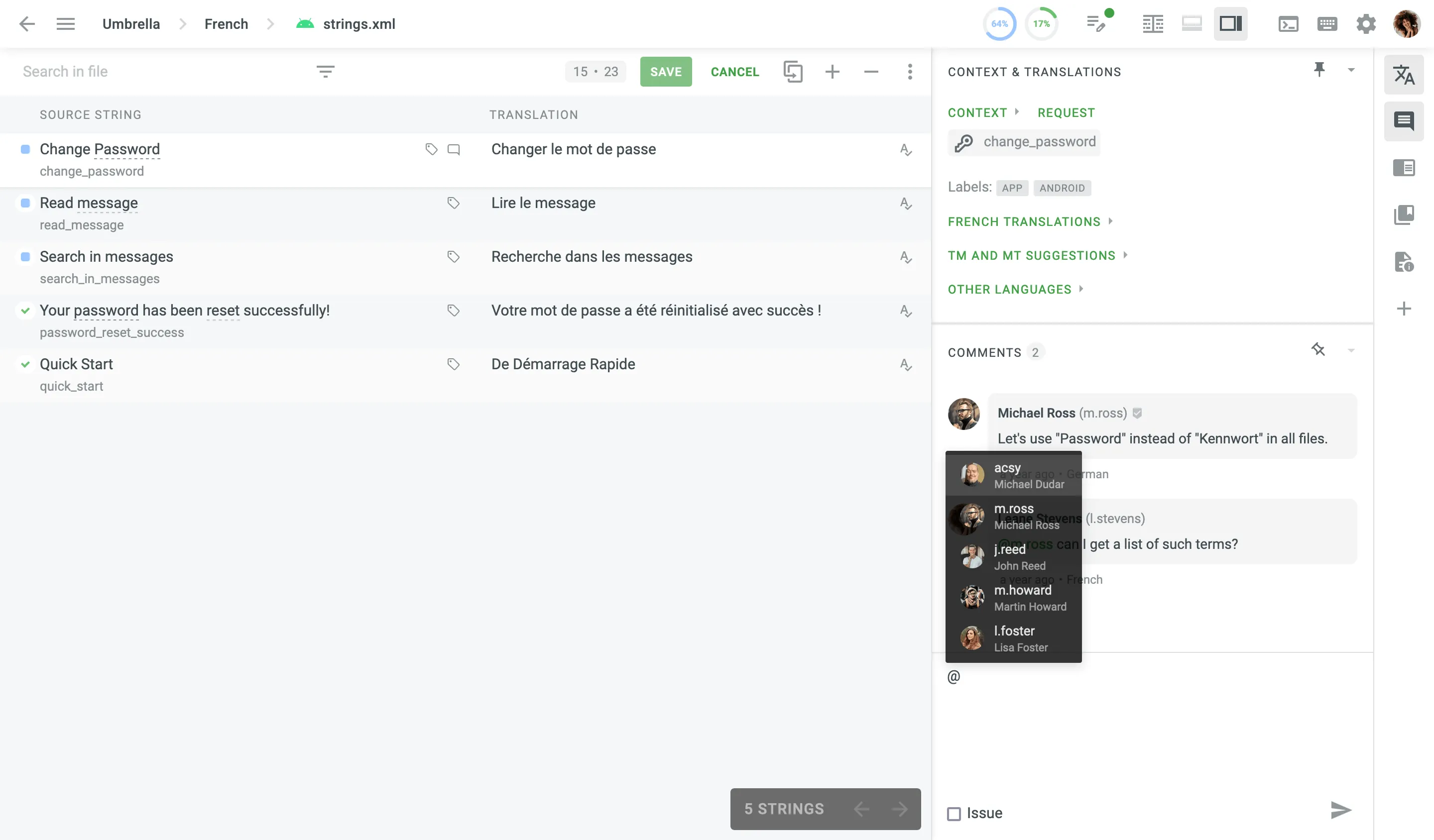
Using the Search TM section, you can check for all the available translations from Translation Memory, which is the vault of translations uploaded to the system by project managers.
The Search TM section provides the following options:
- Source – Search for matches in a source language.
- Target – Search for matches in target languages.
- Guess translation – Highlight probable translation of a search phrase.
- Numeric equivalence – Match digits from a search phrase with any other digits.
Additionally, to maximize your search results, you can use the following wildcards with your search phrase:
Type an asterisk (*) to find words where the end or beginning may be different. Example: any* finds any, anyway, anything Example: *way finds way, anyway, highway
Type a plus sign (+) to find words where the end or beginning must be different. Example: any+ finds anyway, anything, anywhere, except any Example: +way finds anyway, highway, someway, except way
Type a minus sign (-) to exclude words from your search. Example: Save -as
Use quotation marks to find the exact combination of words. Example: “Save as”
Each TM suggestion in the search results also includes details such as the TM name, creation date, and, if available, the name of the contributor who originally submitted the translation.
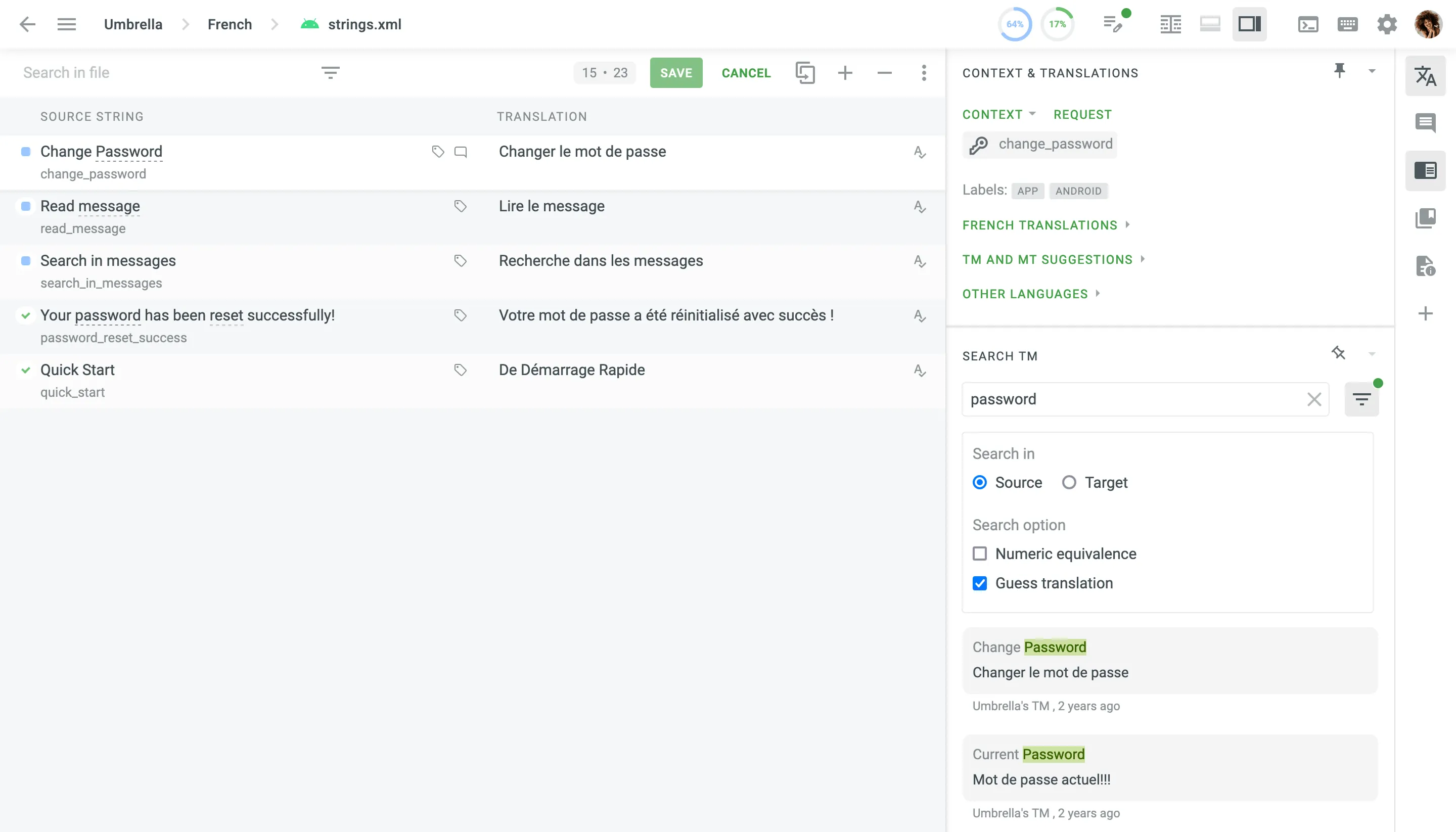
When working in the Editor, you can view the TM suggestions displayed in the TM and MT Suggestions section and in the right sidebar found through the Search TM section. There may be situations where TM suggestions contain inaccuracies or need to be updated.
Project members with manager permissions (or higher) can edit or delete TM records directly in the Editor, both in the TM and MT Suggestions section and in the Search TM section, rather than having to go to the Translation Memories page in the Resources or Project Settings. This ensures that TM suggestions are updated safely and quickly, improving the overall quality of the TM.
To edit the TM suggestion, follow these steps:
- Click in the TM and MT Suggestions section or Edit in the Search TM section.
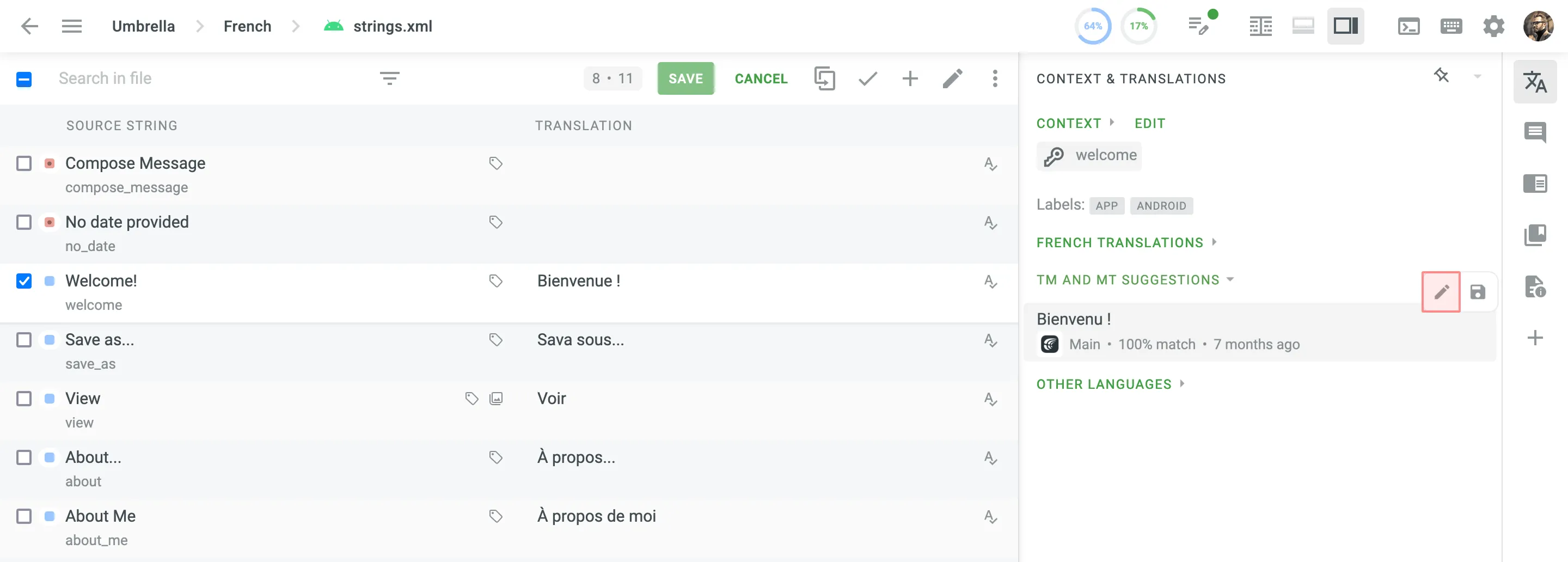
- In the appeared dialog, make the necessary edits (i.e., modify or delete) to the TM suggestions for each language present in the TM segment.
- To revert accidental deletions or unwanted changes, click Undo next to the TM suggestions or click Cancel to revert all modifications before saving.
- Once the desired edits are completed, click Save to confirm and apply these changes to the TM segment.
To completely delete a TM segment from the TM, delete all TM records across all languages and click Save.
Underlined words or phrases in strings indicate project-specific terminology, which should be translated according to the provided term description. You can view detailed explanations by hovering over the underlined text or visiting the Terms section.
The Terms section allows you to browse the project glossary (if available) and search for specific terms. If a term is not found in the glossary, Wikipedia explanations will be displayed as a reference.
Some terms may already have translations, which help maintain consistency across the project. To reuse a translated term, simply click on the underlined text, and its translation will automatically appear in the translation field.
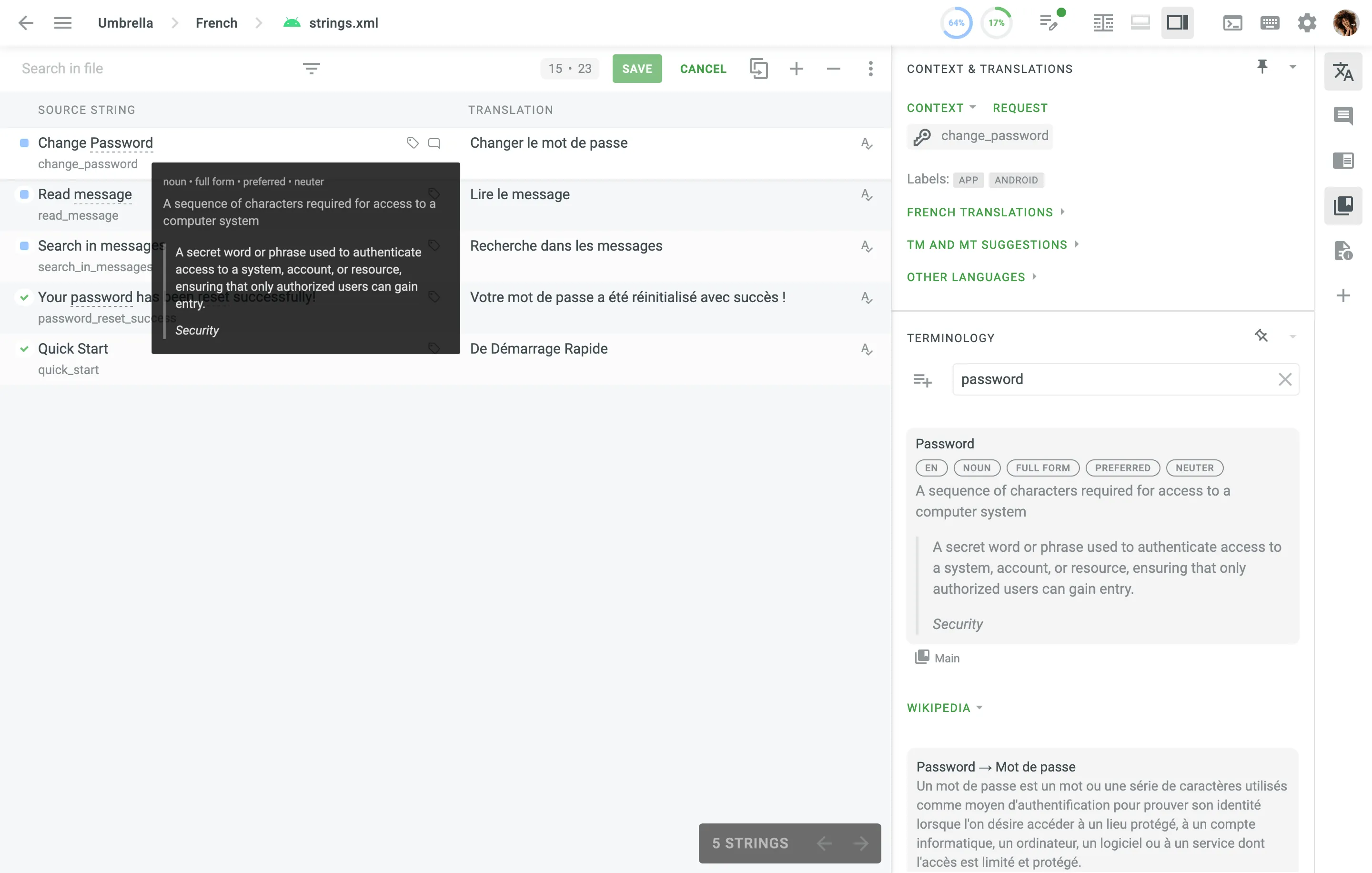
The File Context section allows you to provide translators with additional details to help them understand how to translate a specific file. File context can be added as plain text or Markdown, either directly in the Editor or through the File Settings by the project members with manager permissions (or higher). For other project members, file context is read-only.
To add file context in the Editor, follow these steps:
- Click Add File Context in the File Context section.
- Add the context or instructions for your translators. You can use either plain text or Markdown.
- (Optional) Click Preview to see how the text will appear after saving.
- Click Save.
To edit file context, click the existing text in the File Context section, make your changes, and click Save.
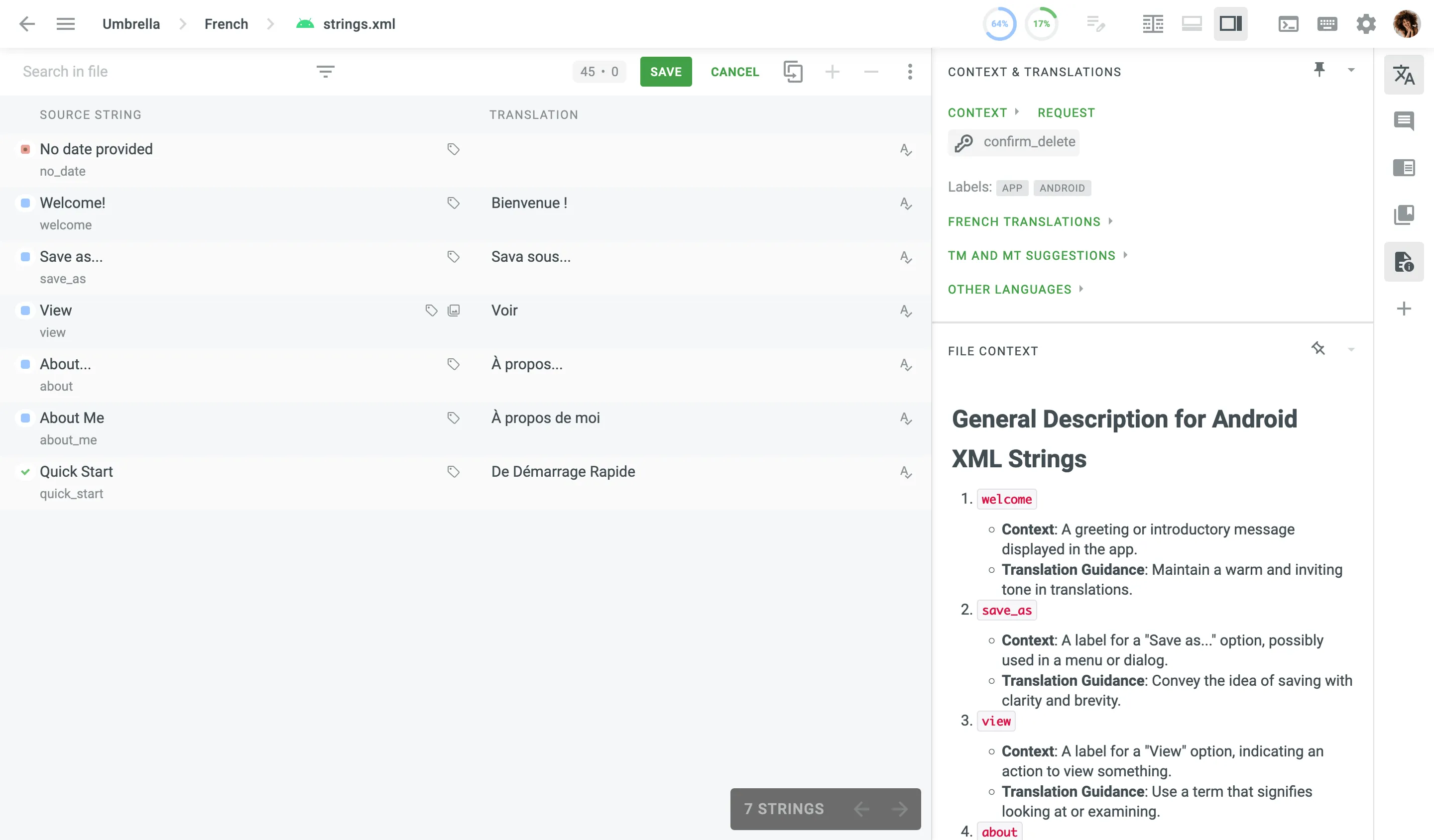
The Editor offers several viewing modes to accommodate different translation workflows. The available modes include Side-by-Side, Comfortable, Multilingual, and Multilingual (Grid), each providing a unique layout for presenting and managing translations. The Side-by-Side mode is enabled by default, but you can easily switch as needed.
You can switch between Editor modes using the following methods:
- Via Main menu – click on the Main menu in the upper-left corner, select View, and choose the preferred mode.
- Via Editor View icon – click the Editor View icon in the upper-right corner and choose the preferred mode.
Side-by-Side mode, detailed in the Core Features section, is ideal for managing multiple translations at once. Translators can work on several strings simultaneously or swiftly review and vote on existing translations. Managers and proofreaders can efficiently approve the best options all within the same view.
Comfortable mode allows translators and proofreaders to focus on one string at a time, ensuring accuracy without distractions. It emphasizes the active string, making it easier to review context and related resources. This mode is ideal for handling complex translations or performing detailed proofreading, where precision and thoroughness are essential.
The main working area with the source string at the top and the translation section below. To add a translation, you need to select a string from the left section, and it will appear in the middle-top Source String field.
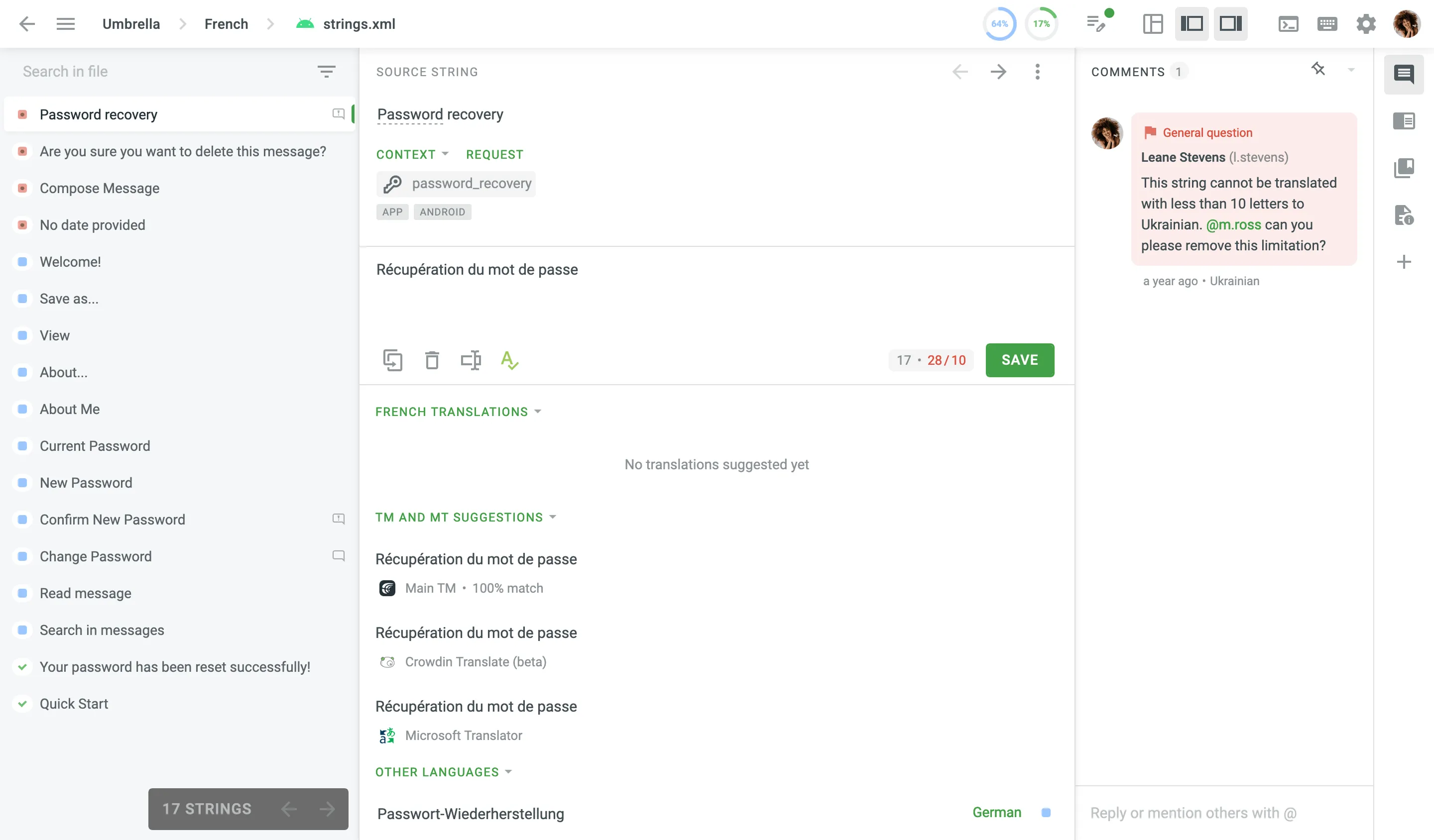
The multilingual mode provides similar features as the side-by-side mode and allows multilingual translators and proofreaders to work with multiple languages at the same time. You can select up to ten languages to work with simultaneously. The right panel shows the string’s translations of the language you’re entering a translation for or the one that was selected last.
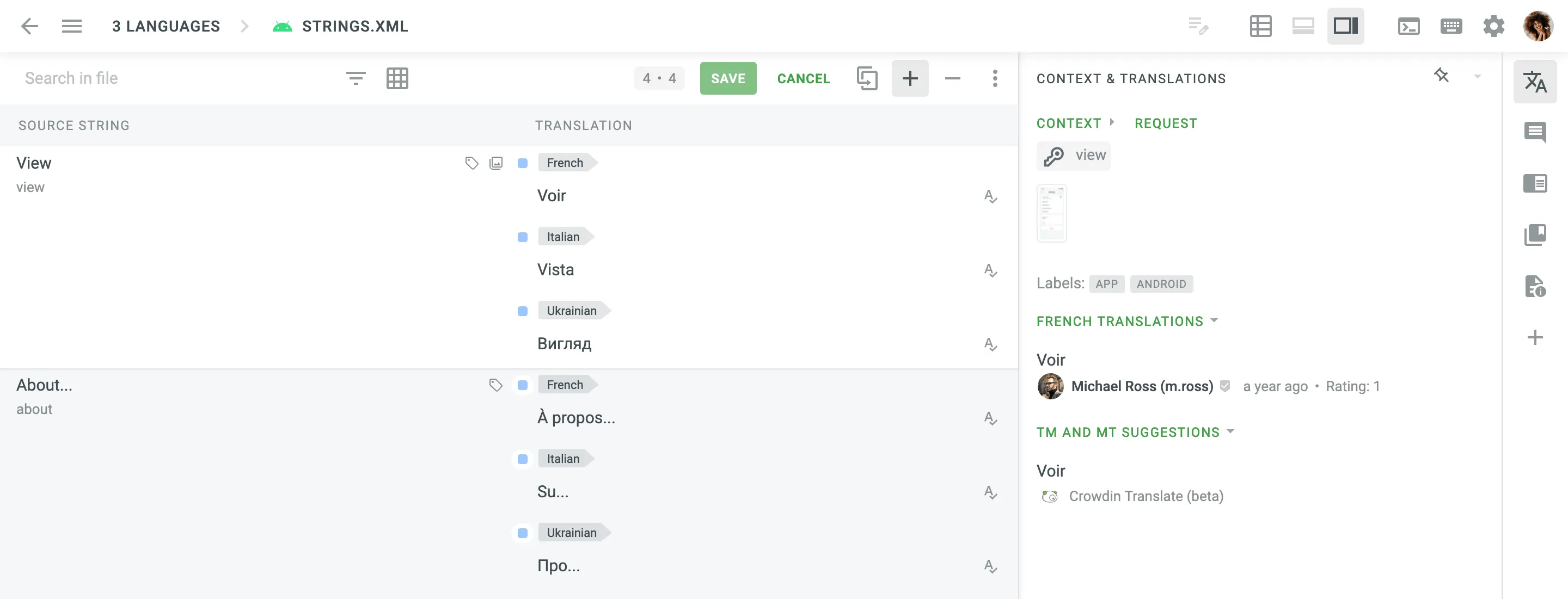
Once you switch to the multilingual mode, select the languages you’d like to work with, and click Apply. To add new languages or remove some of the earlier selected ones, click on the Main menu in the upper-left corner, choose Language, alternatively click on the Languages in the upper-left corner, then do the necessary modifications to the language list and click Apply.
In addition to the multilingual mode, there is a separate Multilingual (Grid) mode. It provides a spreadsheet-like layout where each language is shown in a separate column, allowing you to work with multiple languages in a compact tabular format.
To adjust the order and visibility of columns displayed in this mode, and to pin specific columns, click Sort Columns in the upper-right corner and select the preferred ones. You can also reset the layout to the default column set by selecting Reset To Default at the bottom of the list.
Additionally, to pin or hide individual columns, click the drop-down arrow next to a column title and choose the needed option.
You can also switch between Default View and Compact View using the button in the upper-right corner. The compact option displays more rows by reducing vertical spacing.
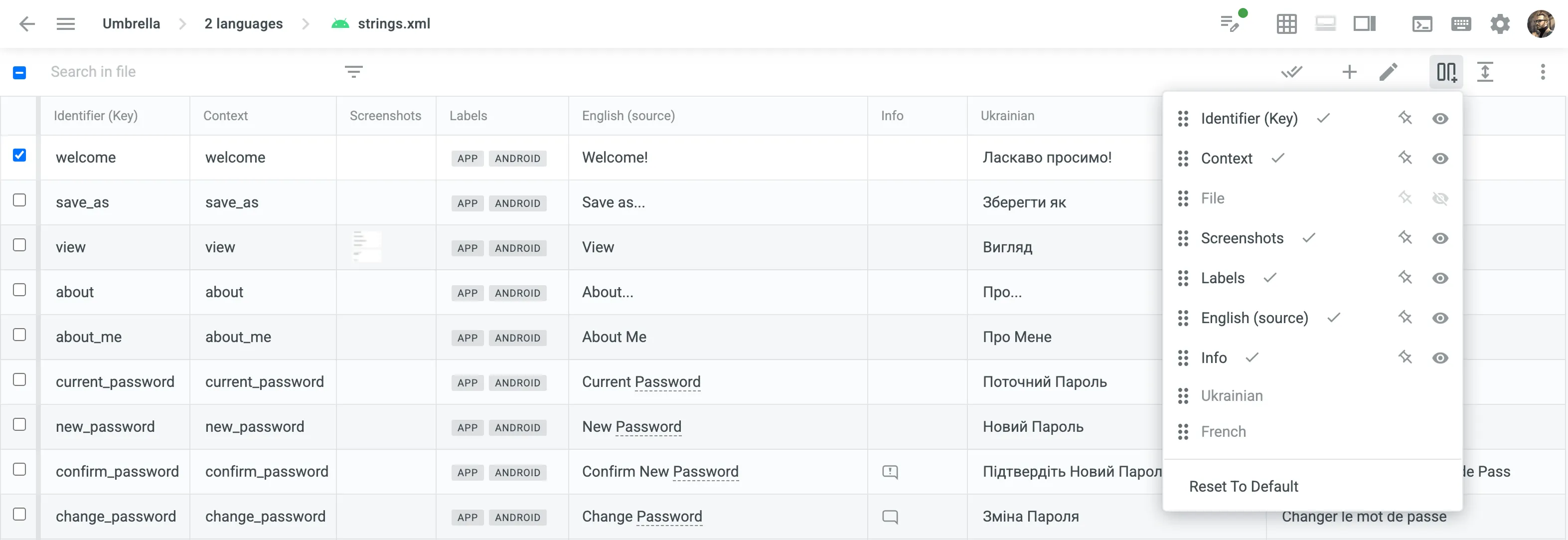
The proofreading process works mainly the same way as in side-by-side mode, except when approving or removing approvals for all or a couple of strings at once, the system performs the action for all languages selected for the multilingual mode.
When using filter options in multilingual mode, the system will show strings that meet the selected criteria for at least one of the selected languages.
This behavior applies to the following filter options:
- Untranslated
- Not Approved
- Approved
- QA issues
- Machine Translations
- Advanced Filter > Translations updated
- Advanced Filter > Translations > Partially translated (plurals)
- Advanced Filter > Translations > Same as source string
- Advanced Filter > Votes
When translating between LTR and RTL languages, some elements in the translation field in the Editor might not be displayed the same way as they will be once exported.
To be sure that RTL translations will be displayed correctly in the exported file, we recommend making translations the following way:
- Click under the source text (or Alt +C key combination).
- Translate the source texts into the target language.
- Leave variables, tags, etc., unchanged in the translation, even if they look wrong. They will be in the right positions in the exported file.

The Command Palette in the Editor is your hub for accessing various commands efficiently. It serves as a central location for all available commands, ensuring a seamless and intuitive experience.
To open the Command Palette, click in the upper-right corner.
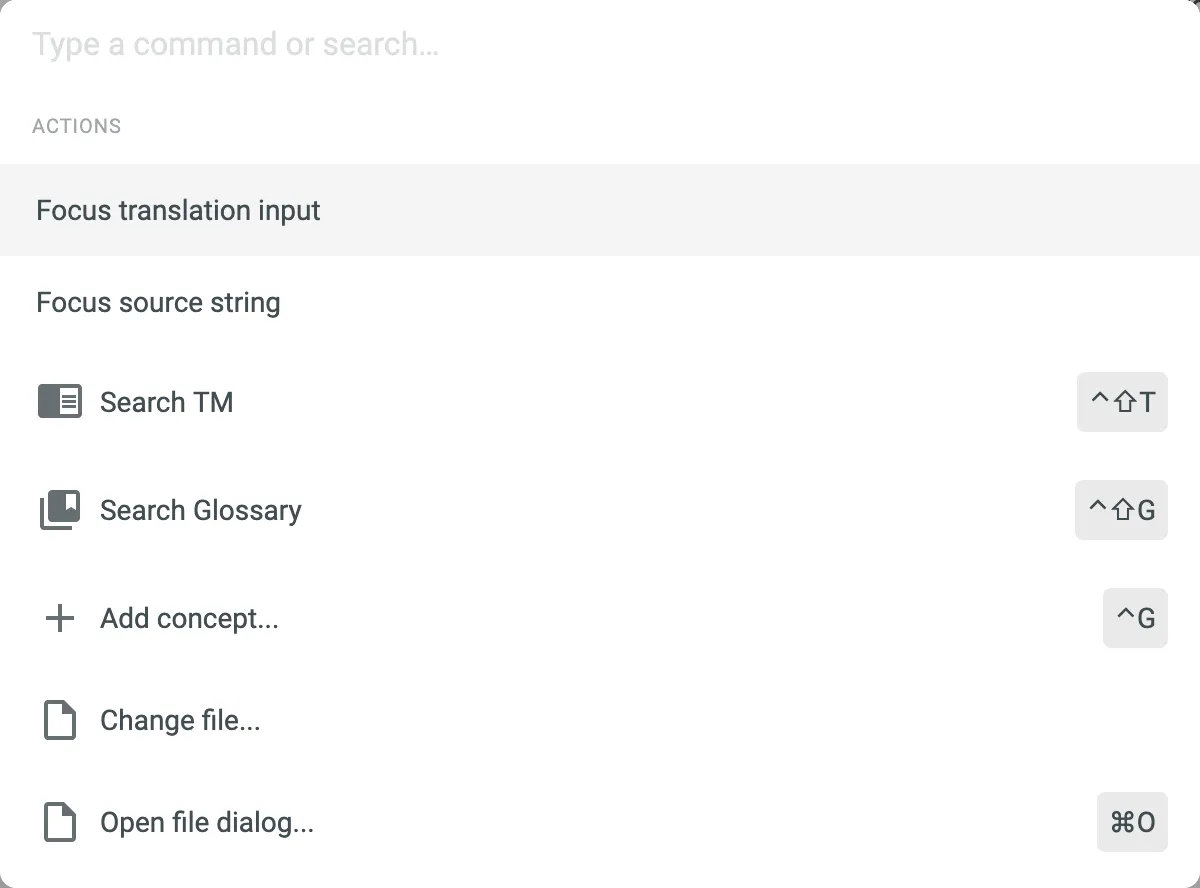
When you enter translations but haven’t saved them, a green indicator appears next to the Unsaved Translations icon. Hovering over or clicking displays a tooltip with the number of unsaved translations.
This feature offers the following options:
- Check the number of unsaved translations.
- Save all unsaved translations with a single click.
- View and manage all strings with unsaved translations.
To view unsaved translations, click in the upper-right corner and select View Strings. Alternatively, click and select Unsaved translations.
Once filtered, you can continue editing unsaved translations. If they are ready to be saved, click Save All to apply the changes.
To open the Editor settings, click in the upper-right corner.
The Editor settings are grouped into tabs that contain various options for configuring the Editor according to your preferences.
- Translation Memory Suggestions – you can specify the minimum similarity match (in percentages) for translation memory suggestions shown under the translation field.
- QA issues – if enabled, the pop-up messages with warnings will appear each time you try to save a translation with some inaccuracy (punctuation/tags/spaces mismatch, missing variables, etc.)

- Auto-complete – if enabled, the pop-up with translation prediction and automatic translation completion will appear while you type the translation.
- Auto-approve – if enabled, the translations added by proofreaders or members with higher permissions are automatically approved.
- Automatically move to next string – if enabled, you’ll be automatically moved to the next string after saving a new translation or approving an existing one.
The AI tab allows to configure custom prompts and shortcuts for AI Assistant. This tab will appear in the Editor settings once the project owner configures AI provider and sets up the AI in editor prompt.
Read more about Using AI in the Editor.
- Default Editor View – set the default view mode that will be used each time you open the Editor.
- Compact strings view – if enabled, only the beginnings of the long strings will be shown in the string list.
- Translation Preview – if enabled, a translation preview will be displayed for translated strings in the string list.
- HTML Tags Displaying – you can choose Show or Hide option that applies to all HTML tags. If you choose Auto, tags will be hidden in HTML, Haml, XML, Web XML, Markdown, and DOCX files but shown in other file formats. When tags are hidden, you can expect the following:
will be replaced with<a href="https://sample.com">Sample</a><0>Sample</0>
- Non-printable characters displaying – if enabled, non-printable characters (e.g., space, tab character, line break, etc.) will be displayed in source texts and translations.
- Translation field highlighting – if enabled, words with potential QA issues will be underlined in the translation field.
- Real-Time Spellcheck – instantly view spelling issues as you type a translation. displayed next to the translation means that no spelling issues were found. Otherwise, you’ll see a red label with the number of spelling issues detected. Click it for more details.
- UI Language – select your preferred language for the Crowdin UI. The chosen language will be applied to the Editor and other parts of Crowdin.
Set the Light or Dark theme, or select Auto to allow the Editor to set the theme based on your device system settings. In addition to the default themes, you can also install custom themes from the Crowdin Store or create your own custom theme.
Use keyboard shortcuts to take actions in the editor quickly. Check the list of keyboard shortcuts by clicking the keyboard icon in the upper-right corner. Most of the hotkeys can be customized to your personal preferences. Click on the necessary key combination, and modify it with the help of your keyboard.
Easy access to most-used menu items in one click:
- Project – click on the current project name (Umbrella in the below screenshot)
- Language – click on the current language (French in the below screenshot)
- Files – click on the current file name (strings.xml in the below screenshot)

Use translation and approval indicators to monitor the progress of the currently opened file or folder. These indicators display the proportion of content that is translated and approved, allowing you to quickly assess the current status.
There are two types of indicators available in the Editor:
- Circular Progress Indicators – Located in the upper-right corner of the toolbar, these show the percentage of translated and approved content for the file or folder you’re working on.
- Detailed Progress Breakdown – Accessible via the Main menu > File, this provides information on the total word count, number of translated, pre-translated, and approved words, along with percentage completion for each.
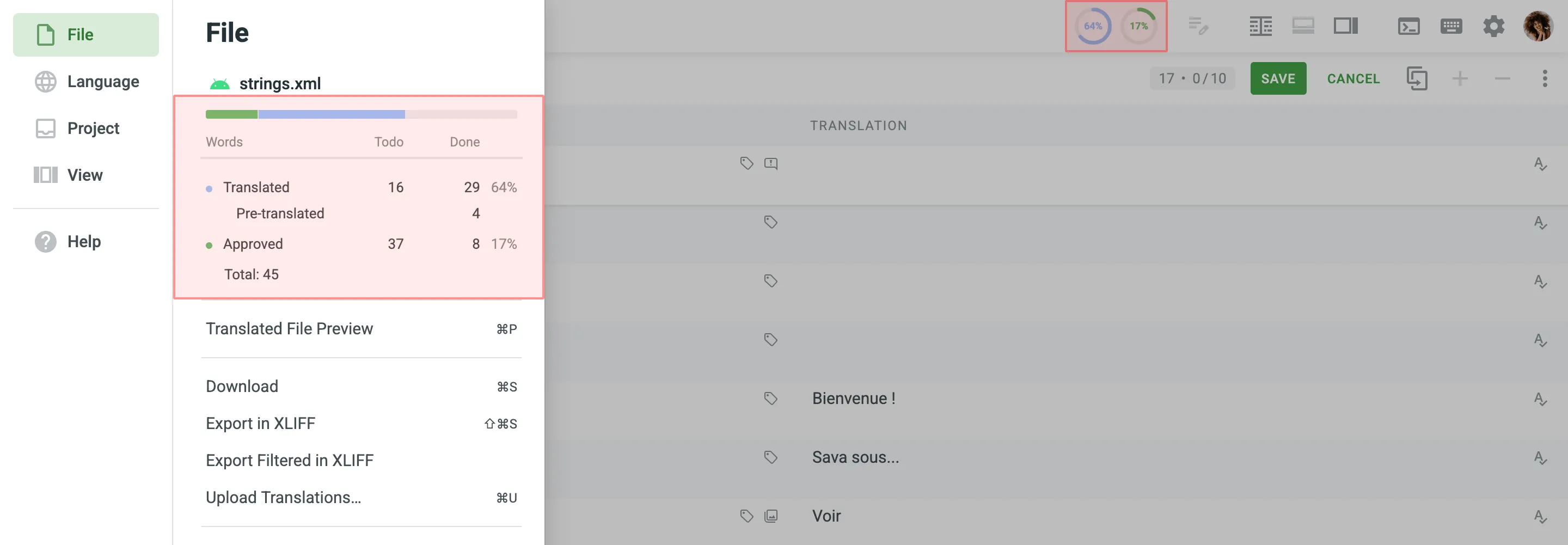
When you select a word or phrase in the source string or translation, the icon will appear. Clicking the icon opens a context menu with several useful options:
- Search TM – Look for Translation Memory (TM) suggestions for the selected word or phrase.
- Search in Terminology and Wikipedia – Find an explanation of the selected word or phrase in the project terminology or Wikipedia.
- Create Term – Add the selected word or phrase to the project glossary as a new term.
- Transform (only available for selected words in the translation) – Access a submenu with options to convert the selected text to lowercase or uppercase.
- Copy – Copy the selected word or phrase to clipboard.
- Copy & Paste – Copy the selected word or phrase and immediately paste it into the translation field.

To translate strings from the other files, follow these steps:
- Click on the Main menu or click on the current file name in the upper-left corner.
- Choose File > Open.
- Select the necessary file and click Open. Alternatively, just double-click on the necessary file.
To see all strings of the project, click on the Main menu in the upper-left corner, and go to File > All Strings. Alternatively, click on the current file name in the upper-left corner > All Strings.
To quickly find and reopen one of the files you recently worked on, click on the Main menu in the upper-left corner, go to File and select the needed file from the Recent files section.
In addition to the WYSIWYG file preview, which shows files as they would appear when rendered, there are Source File Preview and Translated File Preview modes that allow users to view the raw content of both source and translated files directly within the Editor. These previews provide insight into the file’s structure, layout, and formatting, helping users ensure accurate translations within the correct context. This is particularly helpful for identifying discrepancies or formatting issues without leaving the Editor. While the Translated File Preview is available to all users, the Source File Preview is restricted to members with Developer permissions or higher.
To open a file in either of these previews, click on the Main menu in the upper-left corner, go to File, and select the needed file preview mode.
You can easily find and replace suggested translations using the Replace in Translations feature.
To replace previously added translations with the new ones, follow these steps:
- In the project Dashboard tab, select the necessary language.
- Click Translate All or choose a file for translation.
- Click on the Main menu in the upper-left corner.
- Go to File > Replace in Translations.
- Enter the word, phrase, or sentence you want to substitute and the text to replace it with. Similarly to string search, you can use the Match case and Exact match options to refine the search results.
- From the drop-down menu, specify the scope of your search, selecting between File, All files, or Filtered strings options.
- Click Find to preview the strings that will be replaced.
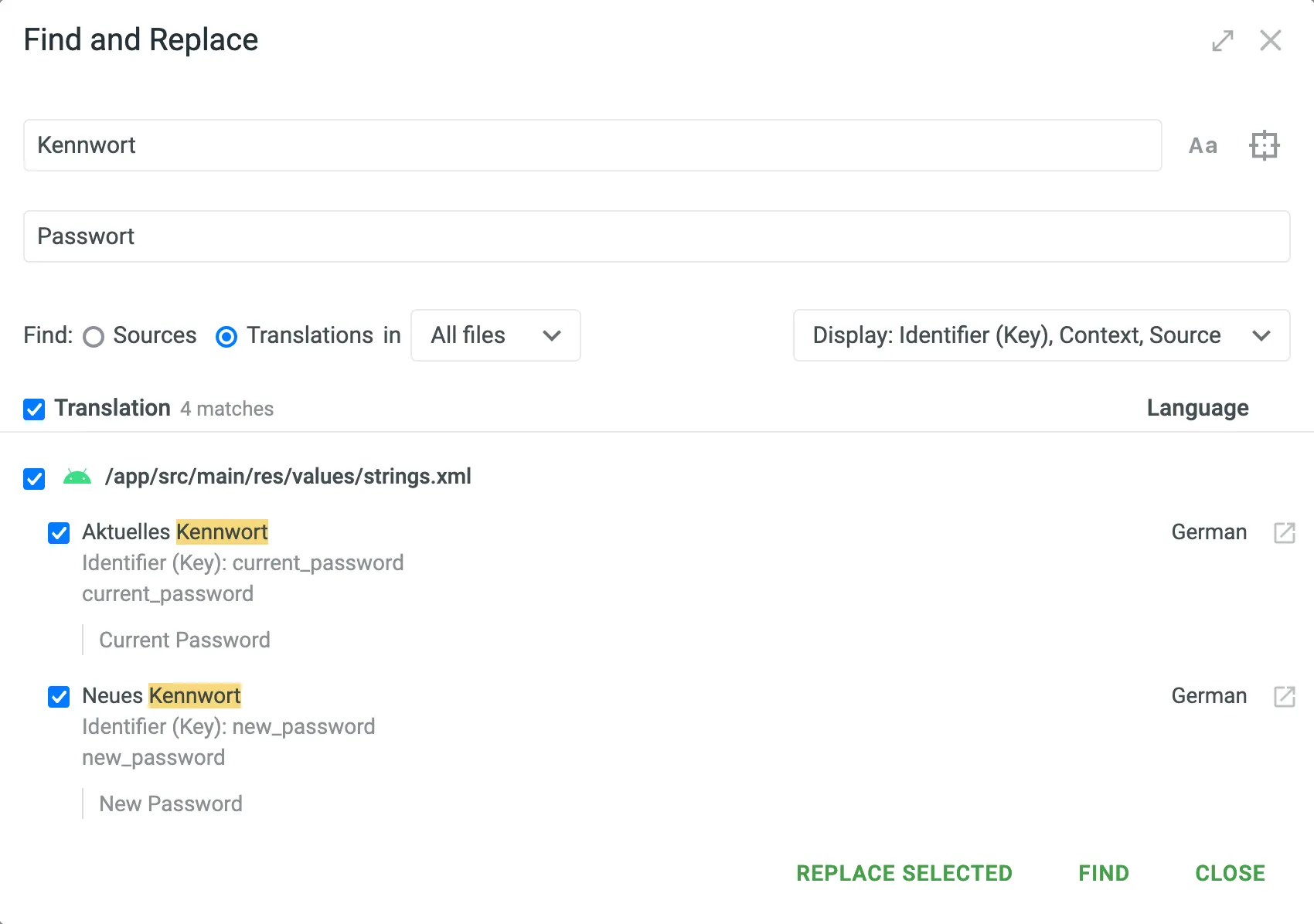
- (Optional) Click the Settings drop-down menu on the right and select what information to display in the search results other than translations. You can choose between Key, Context, and Source.
- Select the translations you want to replace and click Replace Selected to finish.
While translators can perform replacements only in their own translations, project members with proofreader permissions (or higher) can modify all suggested translations. Authorship of translations is preserved.
Project members with developer permissions (or higher) can find and replace source texts using the Replace in Sources feature.
To replace source texts, follow these steps:
- In the project Dashboard tab, select the necessary language.
- Click Translate All or choose a file for translation.
- Click on the Main menu in the upper-left corner.
- Go to File > Replace in Sources.
- Enter the word, phrase, or sentence you want to substitute and the text to replace it with. Similarly to string search, you can use the Match case and Exact match options to refine the search results.
- From the drop-down menu, specify the scope of your search, selecting between File, All files, or Filtered strings options.
- Click Find to preview the strings that will be replaced.
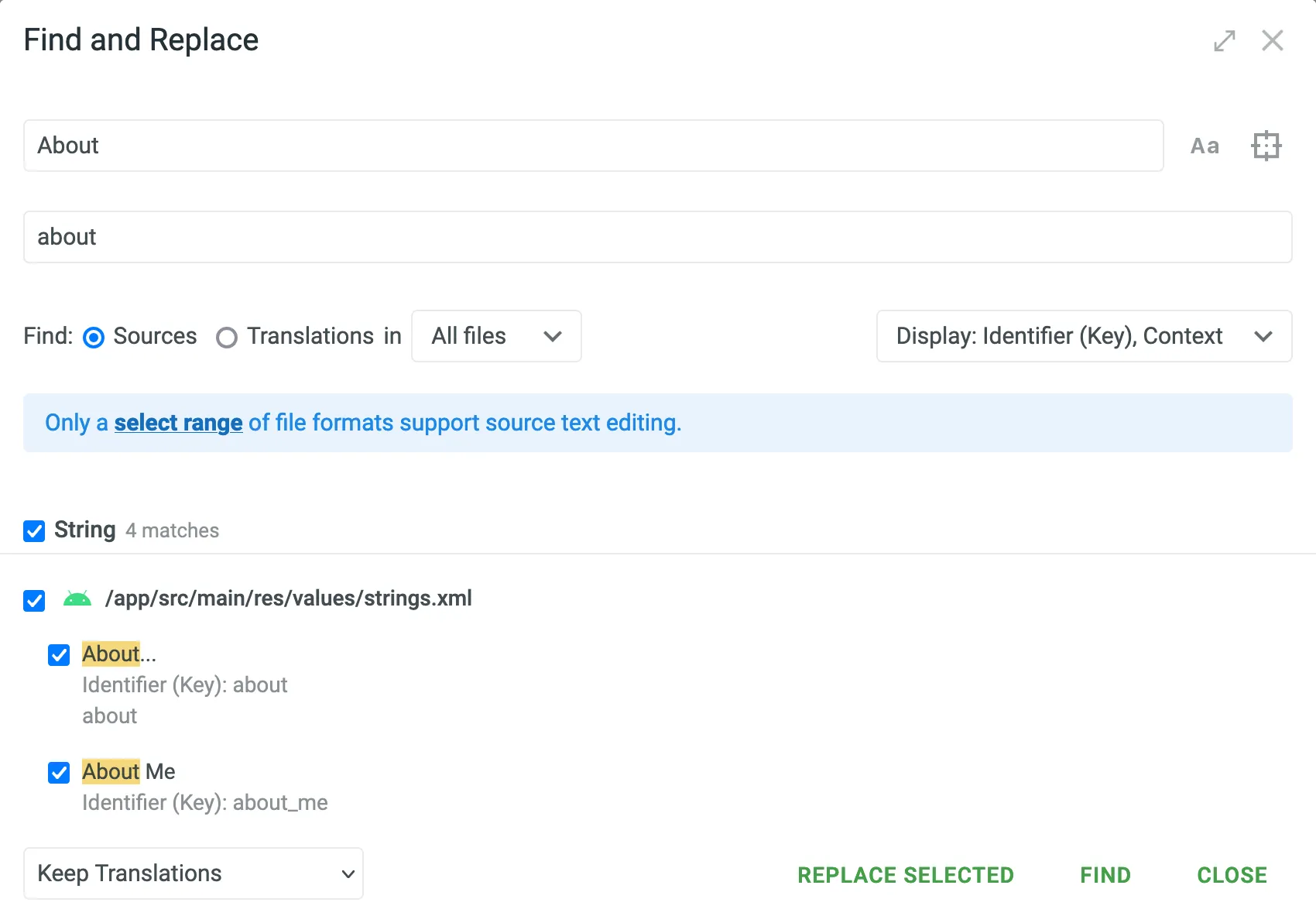
- (Optional) Click the Settings drop-down menu on the right and select what information to display in the search results other than strings. You can choose between Key and Context.
- In the lower-left corner, click the drop-down menu and select the preferred behavior for the translations of the source strings to be replaced. You can choose between Keep Translations, Remove Approvals, or Delete Translations.
- Select the source strings you want to replace and click Replace Selected to finish.
The Pre-translation feature in the Editor allows you to apply translations to multiple strings directly within the Editor using Translation Memory (TM), Machine Translation (MT), or AI. This feature is available to project members with language coordinator permissions or higher.
To apply Pre-translation in the Editor, follow these steps:
- You can apply pre-translation in the Editor in two ways:
- Main menu – click on the Main menu in the upper-left corner, go to File and select the preferred pre-translation method.
- String menu (available in Side-by-Side and Multilingual modes) – click in the upper-right and select the preferred pre-translation method.
- Configure the following pre-translation parameters:
- Scope – select which strings to apply pre-translation to:
- Selected strings (Specific to Side-by-Side and Multilingual modes) – applies only to strings manually selected in the Editor.
- Filtered strings – applies to all strings matching the current filter.
- File – applies to the currently opened file.
- All files – applies to all strings across all files in the project, regardless of the file currently open in the Editor.
- Apply to untranslated strings only – when selected, pre-translation will only be applied to strings that don’t have any translations.
- Allow duplicate translations – adds translations even if they duplicate existing ones. Useful when comparing AI prompts or MT engines in the Pre-translation Accuracy report, as it ensures that all translations are registered as new and included in accuracy calculations.
- Minimum match ratio (Specific to pre-translation via TM) - select either 100% or Perfect match (101%) as the minimum similarity required for TM matches.
Read more about TM Match Types.
- Skip approved translations (Specific to pre-translation via TM and MT) – prevents overwriting strings that already have approved translations.
- Approve added translations (Specific to pre-translation via TM) – allows you to auto-approve translations added through pre-translation. Options include:
- All – approve all added translations.
- With perfect match – approve only those with a 101% match.
- With perfect match (approved previously) – approve perfect matches only if they were already approved before.
- All (skip auto-substituted translations) – approve everything except translations improved by auto-substitution.
- Translation engine (Specific to pre-translation via MT) – select the machine translation engine to use.
- AI prompt (Specific to pre-translation via AI) – select the prompt that will guide the AI model’s behavior during pre-translation.
- Scope – select which strings to apply pre-translation to:
- Click Pre-Translation.
In Side-by-side and Comfortable modes, pre-translation is applied to the single language currently selected in the Editor. In Multilingual mode, translations are applied across all selected languages, as this mode allows working with multiple languages simultaneously.
Read more about Multilingual mode.
Use the Queue option in the String menu to track and manage all triggered pre-translation instances.
Read more about Pre-translation Queue.
You can create a custom filter of strings by clicking the Filter strings icon and choosing Advanced Filter.
Use this filter to define multiple parameters at once, such as:
- strings added or updated within a specific period
- translations updated
- labels
- duplicates, comments, approvals, and more
This helps locate the needed strings faster, especially in large projects.
In the Include by labels and Exclude by labels fields, you can select one or more labels to refine your search. Additionally, choose how selected labels should be evaluated using the Include match rule and Exclude match rule settings:
- All selected labels – returns only strings that match all selected labels (AND logic).
- Any selected label – returns strings that match at least one of the selected labels (OR logic).
This allows you to narrow or expand the filtered results depending on your needs.
Here are a couple of examples of how this logic works in practice:
- Include by labels example – to find strings tagged with both
uiandbutton, select those labels and choose All selected labels as the match rule. - Exclude by labels example – to exclude all strings tagged either
marketingordeprecated, select those labels and choose Any selected label as the match rule.
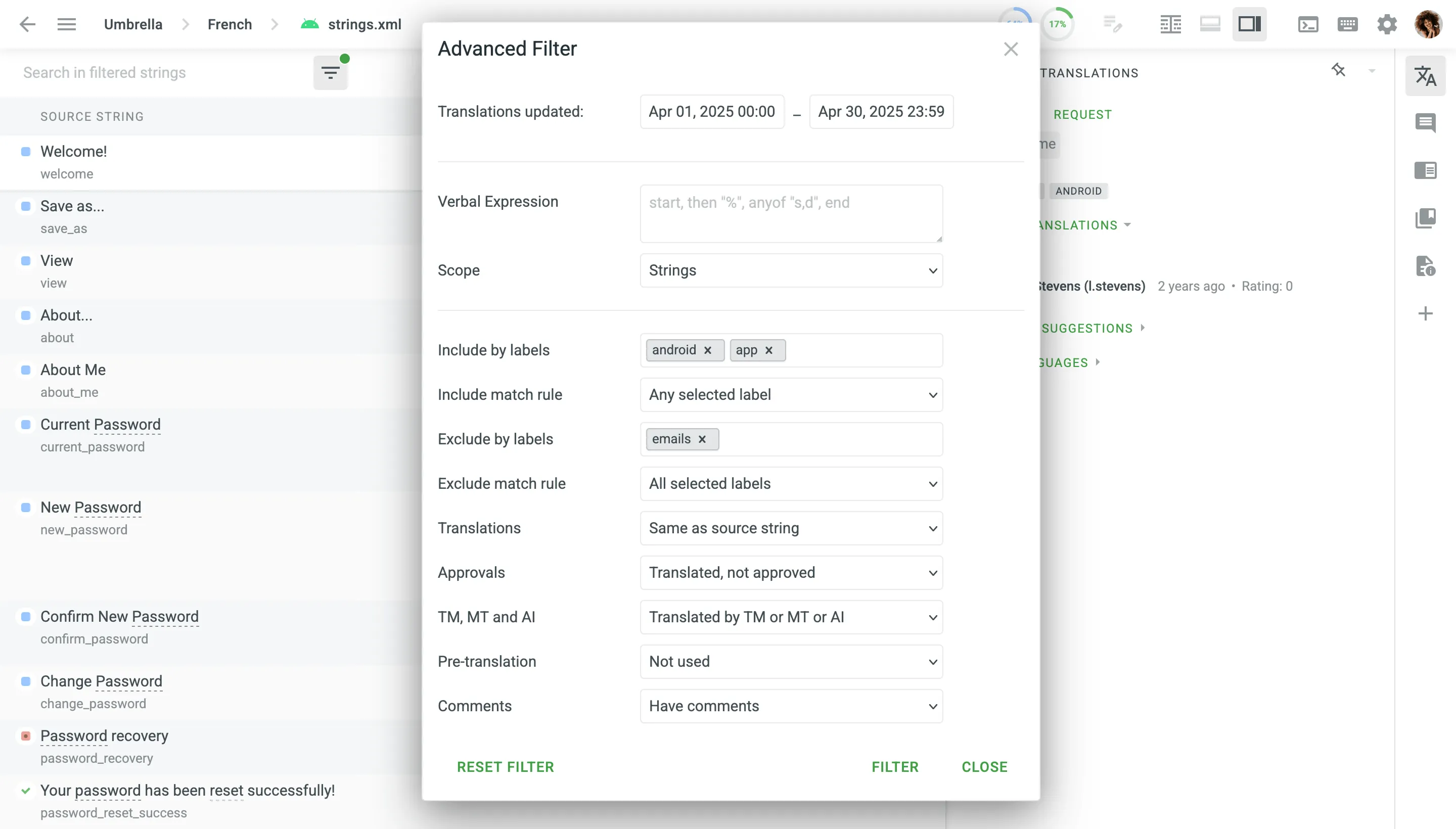
The AI/CroQL Filter allows you to filter strings similarly to the Advanced Filter but offers greater flexibility through the Crowdin Query Language (CroQL).
In the Generate CroQL with AI field, you can write queries in plain text, which will then be transformed into a CroQL expression using AI. To get the best results possible, make sure your queries are clearly structured. For example, you can enter: Return strings where there are translations by the user “username” into Ukrainian. Once you specify your query, press Enter , and the AI will generate and populate the CroQL expression field with the corresponding CroQL expression. Alternatively, you can directly input a pre-prepared CroQL expression in the CroQL expression field.
Click Filter to apply the specified filter to the strings in the Editor or click Reset Filter to clear the current filter settings.
Read more about Crowdin Query Language (CroQL).
In Side-by-Side or Multilingual modes, you can pin specific sections to keep them visible while navigating through other parts of the interface. This helps you access the pinned content quickly without losing sight of essential information.
To personalize your workspace in the Editor, you can reorder the sections in the right panel (e.g., AI Assistant, Context and Translations, Comments, etc.) by dragging their icons.
Click and hold the icon of the section you’d like to move, then drag it to a new position. The updated order will remain applied as you continue working in the Editor.
Once a translator or proofreader has a task assigned, all the task details are accessible from the editor:
The name of the task is displayed at the top of the toolbar.

Filters and searches apply to a particular task only.
Task details can be accessed by clicking the menu in the upper-left corner.
The task menu consists of the following components and features:
- name, due date, language, type of the task, and assignee
- options to download and upload translations for the particular task
- possibility to quit the particular task editor and show all project strings
- Replace in Translations option
- Replace in Sources option
